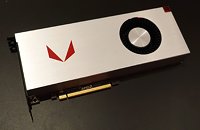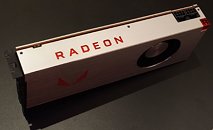Raevenlord
News Editor
- Joined
- Aug 12, 2016
- Messages
- 3,755 (1.25/day)
- Location
- Portugal
| System Name | The Ryzening |
|---|---|
| Processor | AMD Ryzen 9 5900X |
| Motherboard | MSI X570 MAG TOMAHAWK |
| Cooling | Lian Li Galahad 360mm AIO |
| Memory | 32 GB G.Skill Trident Z F4-3733 (4x 8 GB) |
| Video Card(s) | Gigabyte RTX 3070 Ti |
| Storage | Boot: Transcend MTE220S 2TB, Kintson A2000 1TB, Seagate Firewolf Pro 14 TB |
| Display(s) | Acer Nitro VG270UP (1440p 144 Hz IPS) |
| Case | Lian Li O11DX Dynamic White |
| Audio Device(s) | iFi Audio Zen DAC |
| Power Supply | Seasonic Focus+ 750 W |
| Mouse | Cooler Master Masterkeys Lite L |
| Keyboard | Cooler Master Masterkeys Lite L |
| Software | Windows 10 x64 |
TweakTown has put forth an article wherein they claim to have received info from industry insiders regarding the upcoming Vega 56's performance. Remember that Vega 56 is the slightly cut-down version of the flagship Vega 64, counting with 56 next-generation compute units (NGCUs) instead of Vega 64's, well, 64. This means that while the Vega 64 has the full complement of 4,096 Stream processors, 256 TMUs, 64 ROPs, and a 2048-bit wide 8 GB HBM2 memory pool offering 484 GB/s of bandwidth, Vega 56 makes do with 3,548 Stream processors,192 TMUs, 64 ROPs, the same 8 GB of HBM2 memory and a slightly lower memory bandwidth at 410 GB/s.
The Vega 56 has been announced to retail for about $399, or $499 with one of AMD's new (famous or infamous, depends on your mileage) Radeon Packs. The RX Vega 56 card was running on a system configured with an Intel Core i7-7700K @ 4.2GHz, 16 GB of DDR4-3000 MHz RAM, and Windows 10 at 2560 x 1440 resolution.


The results in a number of popular games were as follows:
Battlefield 1 (Ultra settings): 95.4 FPS (GTX 1070: 72.2 FPS; 32% in favor of Vega 56)
Civilization 6 (Ultra settings, 4x MSAA): 85.1 FPS (GTX 1070: 72.2 FPS; 17% in favor of Vega 56)
DOOM (Ultra settings, 8x TSAA): 101.2 FPS (GTX 1070: 84.6 FPS; 20% in favor of Vega 56)
Call of Duty: Infinite Warfare (High preset): 99.9 FPS (GTX 1070: 92.1 FPS; 8% in favor of Vega 56)
If these numbers ring true, this means NVIDIA's GTX 1070, whose average pricing stands at around $460, will have a much reduced value proposition compared to the RX Vega 56. The AMD contender (which did arrive a year after NVIDIA's Pascal-based cards) delivers around 20% better performance (at least in the admittedly sparse games line-up), while costing around 15% less in greenbacks. Coupled with a lower cost of entry for a FreeSync monitor, and the possibility for users to get even more value out of a particular Radeon Pack they're eyeing, this could potentially be a killer deal. However, I'd recommend you wait for independent, confirmed benchmarks and reviews in controlled environments. I dare to suggest you won't need to look much further than your favorite tech site on the internet for that, when the time comes.
View at TechPowerUp Main Site
The Vega 56 has been announced to retail for about $399, or $499 with one of AMD's new (famous or infamous, depends on your mileage) Radeon Packs. The RX Vega 56 card was running on a system configured with an Intel Core i7-7700K @ 4.2GHz, 16 GB of DDR4-3000 MHz RAM, and Windows 10 at 2560 x 1440 resolution.


The results in a number of popular games were as follows:
Battlefield 1 (Ultra settings): 95.4 FPS (GTX 1070: 72.2 FPS; 32% in favor of Vega 56)
Civilization 6 (Ultra settings, 4x MSAA): 85.1 FPS (GTX 1070: 72.2 FPS; 17% in favor of Vega 56)
DOOM (Ultra settings, 8x TSAA): 101.2 FPS (GTX 1070: 84.6 FPS; 20% in favor of Vega 56)
Call of Duty: Infinite Warfare (High preset): 99.9 FPS (GTX 1070: 92.1 FPS; 8% in favor of Vega 56)
If these numbers ring true, this means NVIDIA's GTX 1070, whose average pricing stands at around $460, will have a much reduced value proposition compared to the RX Vega 56. The AMD contender (which did arrive a year after NVIDIA's Pascal-based cards) delivers around 20% better performance (at least in the admittedly sparse games line-up), while costing around 15% less in greenbacks. Coupled with a lower cost of entry for a FreeSync monitor, and the possibility for users to get even more value out of a particular Radeon Pack they're eyeing, this could potentially be a killer deal. However, I'd recommend you wait for independent, confirmed benchmarks and reviews in controlled environments. I dare to suggest you won't need to look much further than your favorite tech site on the internet for that, when the time comes.
View at TechPowerUp Main Site
Last edited:








